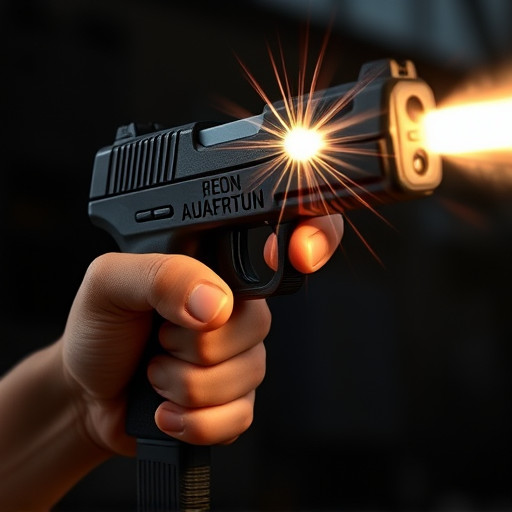Stun guns, also known as electronic control devices (ECDs), work by delivering a high-voltage, low-amperage electric shock through electrodes making contact with an assailant's skin. This sudden discharge disrupts nerve signal transmission to muscles, causing involuntary contractions and severe discomfort, effectively neutralizing the attacker without permanent harm. Key components include a battery, user-activated control mechanism, and one or more electrodes for direct physical contact, vital for optimal electrical transfer in close quarters. Proper training is essential for safe and effective deployment of ECDs.
Stun guns, also known as electronic control devices (ECDs), have become popular for personal protection, especially in close-quarter situations. This article delves into the science behind their effectiveness, exploring the electroshock effect that disables attackers temporarily. We’ll dissect their design and functionality, focusing on key components crucial for optimal performance in confined spaces. Additionally, we’ll highlight effective use cases, offering insights into maximizing the impact of stun guns in such scenarios.
The Science Behind Stun Guns: Understanding the Electroshock Effect
Stun guns, also known as electroshock weapons, operate on the principle of delivering a powerful electric shock to temporarily disable or control an assailant in close quarters. The science behind their effectiveness lies in the physics and physiology of the human body. When activated, a stun gun fires two small electrodes that make contact with the target’s skin, creating a high-voltage, low-amperage electrical discharge. This sudden jolt of electricity disrupts the normal functioning of the nervous system, specifically the motor neurons that control muscle movement.
The electroshock effect is achieved through a process called neuromuscular disruption. The electric current interferes with the transmission of nerve signals, leading to involuntary muscle contractions and severe discomfort. This reaction causes the target to experience a loss of balance, strength, and coordination, effectively neutralizing them in a short period. Understanding this physiological response is key to appreciating how stun guns work as non-lethal self-defense tools, providing individuals with an option to incapacitate assailants without causing permanent harm.
Design and Functionality: Key Components of Close-Quarter Stun Guns
Stun guns, also known as electronic control devices (ECDs), are designed to incapacitate an assailant through electric shock in close-quarter confrontations. Their functionality revolves around delivering a powerful electrical current that disrupts muscle control, causing temporary paralysis. The key components of these weapons include an energy source, a control mechanism, and one or more electrodes.
The energy source, usually a high-voltage, low-amperage battery, powers the stun gun’s electrical circuit. The control mechanism allows the user to activate the device, often with a simple trigger pull or pressure-sensitive button. Electrodes, typically metal probes or contacts, make physical contact with the target, conducting the electric current into their body. This direct contact is crucial for the stun gun’s effectiveness in close quarters, where proximity ensures maximum electrical transfer and rapid neutralization of the assailant.
Effective Use Cases: Maximizing the Impact in Confined Spaces
Stun guns, also known as electronic control devices (ECDs), are designed to incapacitate an attacker through electrical impulses rather than physical force. Understanding how they work is crucial when considering their effective use cases, especially in confined spaces. In close quarters, like tight corridors or small rooms, the proximity of the user and target ensures that the stun gun’s energy is concentrated directly on the assailant, maximising its impact.
The device emits a high-voltage, low-current electrical pulse that disrupts the nervous system, causing muscle spasms and temporary paralysis. In confined areas, this effect can be even more powerful as there’s less space for the attacker to maneuver or escape, leading to quicker incapacitation. Proper training in ECD usage is essential to ensure safe and effective deployment, especially in close-quarter situations where every second counts.
